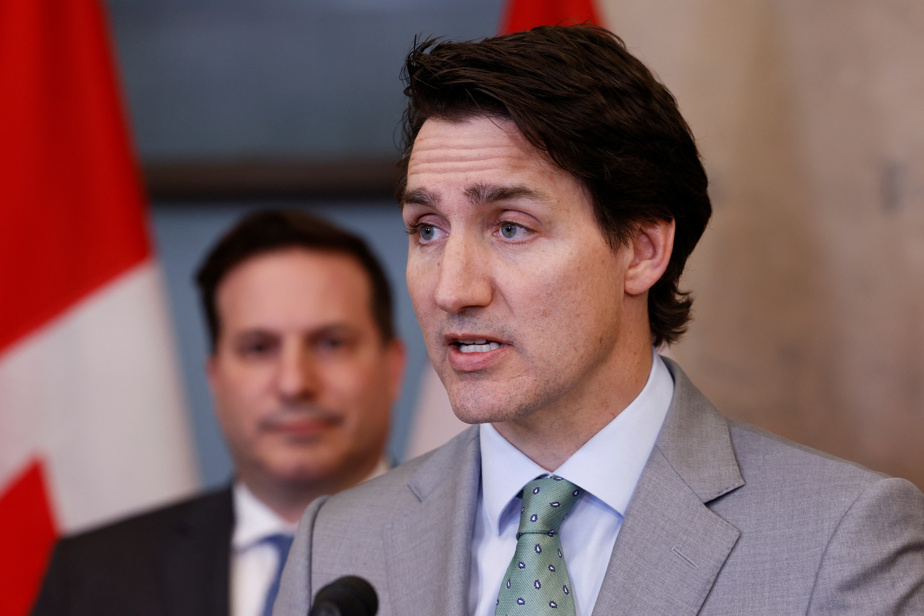(Ottawa) While the federal Liberal government publicly insists that the Trans-Pacific Partnership should welcome any country that meets the standards of this regional free trade agreement, an internal document suggests that Justin Trudeau would prefer that China not be able to join. join.
His comments stem from the internal record of a phone call between Mr Trudeau and former British Prime Minister Liz Truss last summer, shortly after he began his term at 10 Downing. Mme Truss is no longer in post today.
A Canadian diplomat in London transmitted an “unofficial report” to Ottawa on September 11, summarizing the telephone conversation, and of which The Canadian Press obtained a copy thanks to the Access to Information Act.
The document indicates that M.me Truss believed that the United States and the European Union should be part of this “Comprehensive and Progressive Agreement for Trans-Pacific Partnership”, which includes Canada and ten other countries in Asia and Latin America – and which will soon involve the Kingdom. -United.
According to the minutes, Prime Minister Trudeau “took the opportunity to emphasize that this was exactly why it was so important to set the bar so high, so that the United Kingdom could join the Accord” and “that it makes [trop] difficult for China to join. The minutes add that Premier Truss agreed with this assertion.
Unusually direct rhetoric for economics professor Meredith Lilly of Carleton University, who served as Prime Minister Stephen Harper’s trade adviser. “I don’t think it’s something that would be phrased that way in public,” she said.
By consensus of members
Canada insists it has no position on whether China can join the trading bloc: Ottawa instead says any country can be admitted if it meets criteria set by group members, including the right to organize and environmental objectives.
Last Friday, Commerce Minister Mary Ng echoed that message when asked specifically about China joining the free trade agreement.
“The Partnership works by consensus among all trading partners. And we’re going to have to think about how we deal with membership applications,” she told a conference organized by the Canadian Global Affairs Institute.
“Compliance and enforceability of environmental standards, labor standards, their inclusive nature, a track record as a compliant business partner – these are the kinds of things [nous] let’s discuss. »
China has applied to join the trading bloc in September 2021, but must get support from all members. Professor Lilly points out that Canada is one of the main voices within the Partnership, as it is one of the largest economies in the group, along with Japan and Australia.
However, Australian Trade Minister Don Farrell said last fall: “I don’t believe there is any prospect of China joining”, given that Beijing tends to block trade for policies.
Too major reforms
Professor Lilly did not see Ottawa taking such a public position. “It is very important for the Partnership to maintain its open architecture,” she admitted. But the barriers to joining are expected to be extremely high, so a country like China is unlikely to qualify. »
Because it is unlikely, according to her, that China is considering a series of reforms that it would have to undertake then, in particular all the questions relating to state-owned enterprises, market access and provisions relating to currencies.
“Membership cannot simply be based on a promise to be better in the future, precisely because China in particular has made certain commitments in the past which it has subsequently failed to meet,” said she declared.
“It is important to stick to ambitious rules and standards because it always creates an opportunity for a country to change – so it is not just a dogmatic decision to refuse a country. »
“In the interests of Canada”
The Chinese Embassy in Ottawa says it has noticed growing interest among Canadian experts for China to join the trading bloc. Beijing notes that joining would triple its consumer base and provide Canada with “huge” business opportunities. The embassy maintains that it is “in close contact” about joining the agreement.
“China’s application to join the Partnership is one of the major steps to further expand its openness,” a statement said. It is in line with China’s interests, the interests of all members of the Partnership, including Canada, the interests of the Asia-Pacific region, and the interests of global economic recovery. »
The free trade agreement includes Canada and ten other Asia-Pacific countries: Australia, Brunei, Chile, Japan, Malaysia, Mexico, New Zealand, Peru, Singapore and Vietnam.
Professor Lilly also points out that most members of the trading bloc are smaller economies, but have stronger economic ties to Beijing. However, many of these countries do not want to be perceived as taking sides in the growing rivalry between the United States and China.
Taiwan, a democratic, self-governing island that China claims as part of its own territory, applied to join the trading bloc around the same time as Beijing, and many countries remain mum on the merits of either. other membership.
In addition, Professor Lilly points out, the fact that neither Washington nor Beijing is part of the trading bloc gives smaller economies more scope to advance their own interests within the Partnership.
In a written statement, Global Affairs Canada says membership in the Trans-Pacific Partnership depends on countries supporting open markets and high regulatory standards.
“Canada’s position on any economy aspiring to join will always be guided by the best interests and values of Canadian workers and businesses,” spokesperson Charlotte MacLeod wrote.
